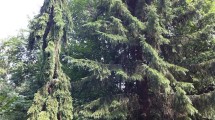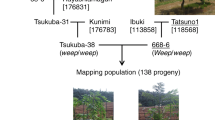Abstract
The pendula phenotype of Norway spruce [Picea abies (L.) Karst f. pendula] is characterized by narrow crowns and strong apical dominance and is controlled by a single dominant gene (P). This defined genetic control presents one of the few opportunities to map a single gene controlling a morphological trait in a forest tree. We used random amplified polymorphic DNA (RAPD) markers and bulked segregant analysis to identify one locus OPH10_720, linked to the pendula gene. The estimated recombination frequency (r) between OPH10_720 and P was 0.046 (SE r =0.032). Mapping of the pendula gene is an important first step towards the ultimate identification and cloning of this gene.
Similar content being viewed by others
References
Adams WT, Joly RJ (1980) Linkage relationships among twelve allozyme loci in loblolly pine. J Hered 1:199–202
Barua UM, Chalmers KJ, Hackett CA, Thomas WT (1993) Identification of RAPD markers linked to a Rhynchosporium secalis resistance locus in barley using near-isogenic lines and bulked segregant analysis. Heredity 71:177–184
Devey ME, Delfino-Mix A, Kinloch BB Jr, Neale DB (1995) Random amplified polymorphic DNA markers tightly linked to a gene for resistance to white-pine blister rust in sugar pine. Proc Natl Acad Sci USA 92:2066–2070
Ellis DD, McCabe DE, McInnis S, Ramachandran R, Russel DR, Wallace KM, Martinell BJ, Roberts DR, Raffa KF, McGown BH (1993) Stable transformation of Picea glauca by particle accelaration. Bio/Technol 11:84–89
Hakman I, von Arnold S (1985) Plantlet regeneration through somatic embryogenesisi in Picea abies (Norway spruce). J Plant Physiol 121:149–155
Hormaza JI, Dollo L, Polito VS (1994) Identification of a RAPD marker linked to sex determination in Pistacia vera using bulked segregant analysis. Theor Appl Genet 89:9–13
Kärki L (1985) Genetically narrow-crowned trees combine high timber quality and high stem wood production at low cost. In: Tigerstedt PMA, Puttonen P, and Koski V (eds) Crop Physiology of Forest Trees. Helsinki University Press, pp 245–256
Kesseli RV, Wistenboer H, Stanghelliini M, van der Mark G (1993) Recessive resistance to Plasmopara lactucea-radicis maps by bulked segregant analysis to a cluster of dominant disease resistance genes in lettuce. Mol Plant-Microbe Inter 6:722–728
Lepistö M (1985) The inheritance of pendula spruce (Picea abies f. pendula) and utilization of the narrow-crowned type in spruce breeding. Foundation for Forest Tree Breeding, Information 1:1–6
Michelmore RW, Paran I, Kesseli RV (1991) Identification of markers linked to disease-resistance genes by bulked segregant analysis:a rapid method to detect markers in specific genomic regions using segregating populations. Proc Natl Acad Sci USA 88:9828–9832
Murray MG, Thompson WF (1980) Rapid isolation of high-molecular-weight plant DNA. Nucleic Acids Res 8:4321–4325
Pöykkö TV, Pulkkinen P (1990) Characteristics of normal-crowned and pendula spruce [Picea abies (L.) Karst.] examined with reference to the definition of a crop-tree ideotype. Tree Physiol 7:201–207
Pulkkinen P, Pöykkö TV (1990) Inherited narrow crown form, harvest index and stem biomass production in Norway spruce, Picea abies. Tree Physiol 6:381–391
Williams JGK, Kubelik AR, Livak KJ, Rafalski JA, Tingey SV (1990) DNA polymorphisms amplified by arbitrary primes are useful as genetic markers. Nucleic Acids Res 18:6531–6535
Author information
Authors and Affiliations
Additional information
Communicated by P. M. A. Tigerstedt
Rights and permissions
About this article
Cite this article
Lehner, A., Campbell, M.A., Wheeler, N.C. et al. Identification of a RAPD marker linked to the pendula gene in Norway spruce (Picea abies (L.) Karst. f. pendula). Theoret. Appl. Genetics 91, 1092–1094 (1995). https://doi.org/10.1007/BF00223924
Received:
Accepted:
Issue Date:
DOI: https://doi.org/10.1007/BF00223924




